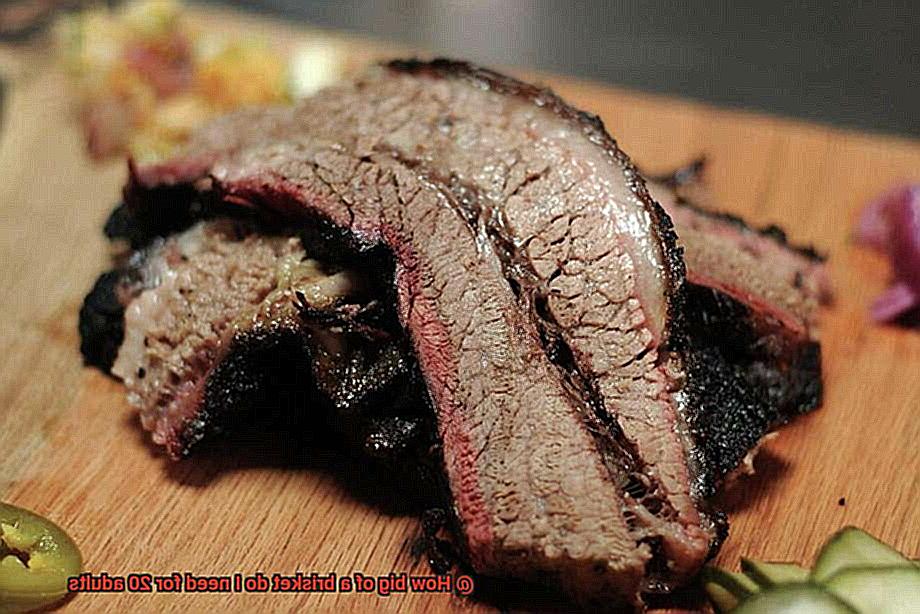Imagine it: a juicy, smoky brisket that fills the air with its irresistible aroma, making mouths water and creating an all-out drool fest. As you envision those tender slices of meat on everyone’s plates, one question haunts you: “How much dang brisket do I need to satisfy my ravenous crew of 20 adults?”
Feeding a big group is no easy task, but nailing the perfect portion size is key to hosting a legendary gathering. And when it comes to barbecue classics, brisket reigns supreme. Lucky for you, as a meat aficionado extraordinaire, I’m here to help you crack the code on this vital calculation.
First things first – let’s talk about portion sizes. A safe bet is to serve up six ounces of cooked brisket per person. With 20 grown-ups ready to chow down, we’re talking about a grand total of 120 ounces or a mouthwatering 3.4 kilograms of pure deliciousness.
But hold your horses. There are a few other factors to consider. Are your guests hardcore carnivores or will they have other options on their plates? Do you anticipate some leftover brisket for those epic next-day sandwiches or midnight fridge raids? These details might bump up your required amount.
And don’t forget about the cooking process itself. Brace yourself for some shrinkage – during cooking, that beautiful hunk of meat loses around 30% of its weight. So make sure you take that into account when purchasing your prime cut.
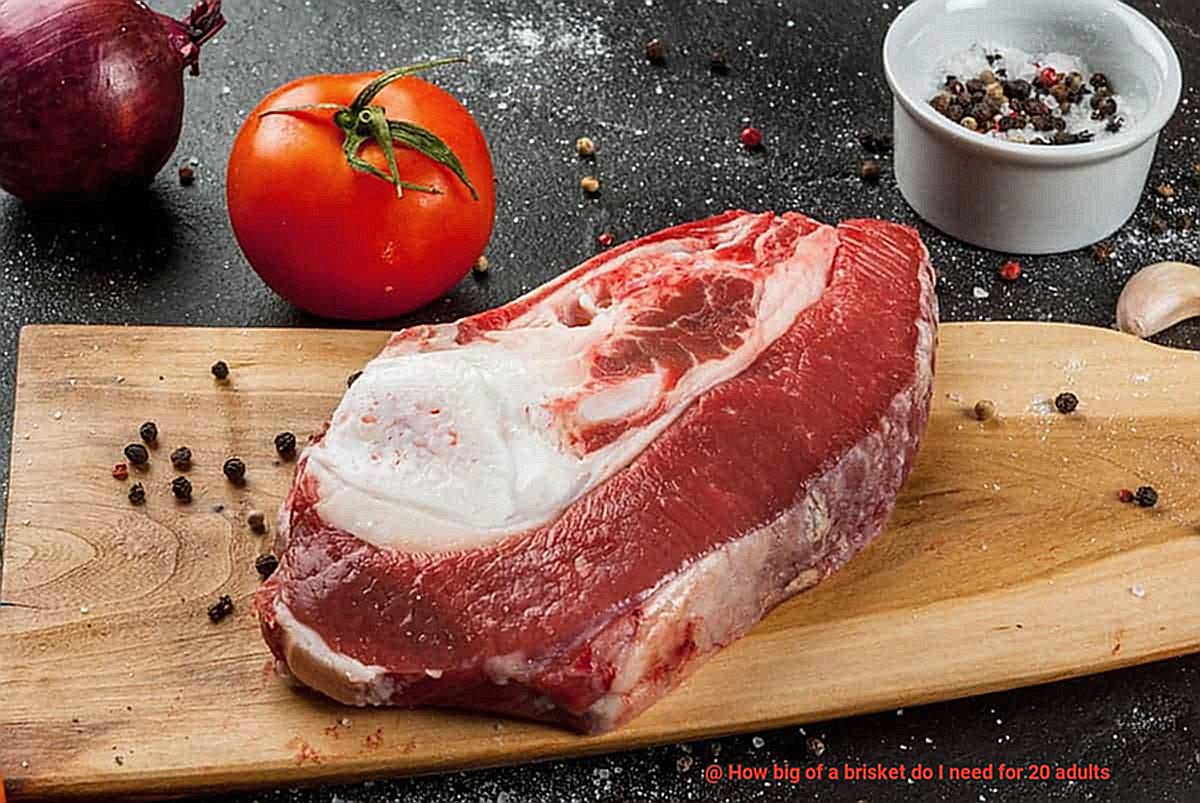
Now equipped with these essential nuggets of wisdom, you’re ready to embark on your journey towards brisket perfection. Join me as we venture deeper into the world of barbecuing – uncovering secret seasoning techniques, exploring different cuts and cooking methods – all in pursuit of treating your guests to a hearty feast they won’t soon forget. Brace yourselves, pitmasters-in-training, because we’re about to dive into the mouthwatering adventure of gauging your guests’ insatiable appetites.
So buckle up and get ready for a wild ride. The smoke signals are calling, and the tantalizing brisket experience awaits. Let’s make this meal one for the record books.
Contents
Calculating the Amount of Brisket Needed for 20 Adults
When it comes to hosting a gathering with a mouthwatering brisket as the centerpiece, nailing the perfect quantity is crucial. In this comprehensive guide, we will unveil the secrets to calculating the precise amount of raw brisket needed to satisfy the appetites of 20 adults. By considering factors like serving size, yield percentage, cooking method, and individual preferences, you can ensure an unforgettable feast that leaves your guests impressed and satiated.
Determine the Ideal Serving Size:
First and foremost, let’s tackle the challenge of determining the right serving size per person. As a general guideline, planning for approximately 1/2 pound (8 ounces) of cooked brisket per adult is recommended. However, if you anticipate having some hearty eaters or if brisket takes center stage on your menu, consider upping the serving size to a generous 10 ounces per person.
Factor in the Yield Percentage:
Brisket is a rugged cut of meat that requires a low and slow cooking process to achieve delectable tenderness and flavor. During this culinary journey, moisture loss and fat rendering cause the brisket to lose weight. On average, expect a weight loss of around 30% during cooking. Therefore, it’s crucial to account for this shrinkage when calculating the required amount of raw brisket.
Unleash the Power of Calculation:
To unveil the exact quantity of raw brisket needed for your gathering, we present you with a handy formula:
Total weight needed = (Serving size per person) x (Number of adults) / (Yield percentage)
For instance, let’s assume you aim to serve 8 ounces of brisket per adult and have 20 guests attending. Assuming a yield percentage of 70%, the calculation would look like this:
Total weight needed = (8 ounces/person) x (20 adults) / (0.7) = 228.57 ounces
In this scenario, you should procure approximately 229 ounces, which is roughly 14 pounds of raw brisket to satisfy the appetites of all 20 adults.
Considerations When Selecting the Size of a Brisket
As we strive for culinary excellence and aim to satisfy our guests’ taste buds, let us explore the crucial considerations when determining the size of this delectable cut. So, don your chef’s hat and join us as we delve into the intricacies of brisket selection.
Consideration 1: The Art of Portioning
Before we embark on this gastronomic adventure, let us first delve into the art of portioning. Imagine each adult savoring a generous half-pound (8 ounces) of succulent, mouthwatering brisket. With 20 adults to please, you should aim for a minimum of 10 pounds of cooked brisket.
However, to ensure an abundance of finger-licking goodness and perhaps a few delightful leftovers, opt for a brisket weighing between 12-15 pounds. Trust us, it’s well worth it.
Consideration 2: Appeasing Appetites and Pleasing Palates
In our quest to create an unforgettable feast, we must cater to diverse appetites and preferences. Consider your guests’ voracious cravings or their unbridled love for brisket. For those with hearty appetites or true brisket enthusiasts, a larger-sized brisket is essential to appease their hunger pangs and leave them wholly satisfied.
Conversely, if you plan on serving other tantalizing main dishes alongside the centerpiece brisket or have guests with daintier appetites, a smaller-sized brisket will suffice while still delivering gastronomic delight.
Consideration 3: Cooking Alchemy and Shrinkage Sorcery
Brace yourself for the alchemy that transpires during the cooking process and the resulting shrinkage. As your brisket undergoes its delectable transformation, it may lose approximately 30% of its weight.
To serve up a sumptuous 10 pounds of cooked brisket, begin with a raw brisket weighing around 14 pounds. Remember, the path to culinary greatness lies in mastering the art of shrinkage sorcery.
. Bone-In vs Boneless
Today, we embark on a tantalizing exploration of the bone-in versus boneless brisket debate. As an expert in this sizzling subject, I’ve conducted extensive research to help you navigate this meaty conundrum.
So, grab a chair, because we’re about to sink our teeth into some juicy details.
Let’s kick off by unveiling the fundamental dissimilarity between bone-in and boneless brisket.
Picture this: bone-in brisket boasts the succulent meat hugged by its rib bones, while boneless brisket has bid farewell to those bony companions. Now, let’s delve deeper into each option.
When it comes to flavor, prepare yourself for a taste explosion with bone-in brisket. Those bones are like culinary alchemists, infusing the meat with an unparalleled richness and depth as it sizzles away. The marrow tucked within those bones is the secret ingredient that elevates the flavor profile to divine heights – a symphony for your taste buds.
However, if you crave simplicity and precision in your culinary adventures, boneless brisket might be your knight in shining armor. Without any pesky bones to contend with, your knife can glide effortlessly through the meat, yielding perfectly even slices. This is especially ideal for those who are honing their meat-handling skills or simply appreciate a visually pleasing presentation.
- Now, let’s talk about time – cooking time, that is. Brace yourselves, because bone-in brisket demands a bit more patience. The added weight and density of those bones mean you’ll need some extra hours in the kitchen. But fear not, my friends. This extended cooking time often rewards you with a melt-in-your-mouth tenderness and succulence that will have your guests begging for seconds.
- Finances – an influential factor in any decision-making process. Generally speaking, bone-in brisket tends to be more budget-friendly due to the added weight from those bones. However, keep in mind that some trimming or deboning might be necessary before cooking, potentially impacting the overall yield and cost-effectiveness.
- Now, let’s address the elephant in the room – personal preference. This is where individual taste buds take center stage. Some enthusiasts swear by the intensified flavor and enhanced tenderness of bone-in cuts, while others revel in the convenience and ease of working with boneless brisket. It all boils down to what tickles your taste buds and showcases your culinary prowess.
. Shrinkage During Cooking
Today, we embark on a tantalizing journey into the realm of brisket, uncovering a crucial element that often goes unnoticed: the phenomenon of shrinkage during cooking. Don your apron, ignite the grill, and let’s delve into the captivating world of this culinary marvel.
When orchestrating a gathering for 20 adults, it is imperative to factor in the potential shrinkage that occurs when cooking brisket. This delectable cut of beef hails from the chest region of a cow and boasts an abundance of connective tissue and fat. As heat works its magic, these tissues gradually break down and render, causing the brisket to undergo a remarkable transformation.
Now, let’s explore the variables that influence shrinkage. The quality and type of brisket, cooking method, and duration all play a pivotal role in this gastronomic metamorphosis. On average, one can anticipate a brisket to contract by approximately 30% to 40% during the cooking process. Ergo, commencing with a 10-pound raw brisket would yield a mouthwatering bounty of around 6 to 7 pounds of succulent meat.
So how does this revelation impact your upcoming gathering? Picture this: you’re anticipating 20 ravenous adults eagerly awaiting their share of this delectable dish. Calculating an estimated consumption of half a pound (equivalent to 8 ounces) of cooked brisket per person seems reasonable. Taking into account the average shrinkage rate, you would be wise to acquire roughly 1.25 pounds (or 20 ounces) of raw brisket per individual.
However, let us not forget the cardinal rule of culinary prowess – it is always better to err on the side of abundance than to risk running out of meat at your extravagant barbecue feast. Hence, when assailed by doubts, embrace the concept of rounding up. To ensure every guest departs fully satiated and, perhaps, clutching a heavenly doggy bag, consider procuring a grander brisket, such as a 15-pound cut. This guarantees an ample supply of delectable, juicy morsels for all to relish.
. Type of Cooking Method
Prepare to embark on a mouthwatering journey into the realm of brisket. Our previous exploration focused on the enigmatic phenomenon of shrinkage during cooking. Now, let’s delve into the captivating world of cooking methods that can make or break your brisket experience. As an expert in this field, I’ve conducted thorough research and gathered invaluable insights to share with you.
Picture this: you’re organizing a gathering for 20 adults and aiming to send them into a blissful food coma. Determining the perfect size of brisket for this epic feast requires careful consideration. Let’s break it down step by step:
First and foremost, let’s dive into the mesmerizing art of smoking. This slow-cooking technique involves tantalizing your brisket over indirect heat for hours on end. Brace yourself, because smoking has a magical effect that causes your brisket to shrink ever so slightly. It’s like witnessing a culinary illusion.
To account for this mysterious shrinkage, a reliable rule of thumb is to plan for approximately half a pound of uncooked brisket per person. So, for your gathering of 20 adult guests, you’ll need around 10 pounds of uncooked brisket. But remember, my friend, it’s always better to err on the side of abundance rather than risking hungry guests.
Now, let’s shift gears and explore the enchanting realm of braising. This method involves immersing your brisket in a liquid bath and cooking it at a low temperature for an extended period of time. Brace yourself for tender and moist meat that will leave your guests craving more.
When braising, you might be able to get away with a slightly smaller cut of meat.
However, don’t forget that portion sizes play a crucial role in satisfying those carnivorous appetites. If you’re feeling especially generous and planning on serving 8-ounce portions of brisket to each adult, you’ll still need approximately 10 pounds of uncooked brisket.
Additional Dishes to Consider
In our previous section, we explored the art of smoking and braising this mouthwatering cut of meat. Now, as an expert in all things brisket, it’s time to take your meal to the next level by considering additional dishes that will complement the star of the show.
Whether you’re hosting a backyard barbecue or a special gathering, these dishes will ensure that your guests leave satisfied and impressed.
Side dishes: Enhancing the Brisket Experience
Alongside the tender and flavorful brisket, elevate your feast with a selection of side dishes that add variety and enhance the overall dining experience. Classic options like coleslaw, macaroni and cheese, baked beans, and cornbread are always crowd-pleasers, providing a perfect balance of flavors and textures.
Don’t forget to incorporate healthier options like grilled vegetables or a colorful salad with a tangy vinaigrette to cater to all taste preferences while keeping your guests happy and well-fed.
Appetizers: Whetting Your Guests’ Appetites
Kick off your meal with a bang by tantalizing your guests’ taste buds with a range of appetizers that will leave them craving for more. Finger foods like sliders, stuffed mushrooms, chicken wings, or mini quiches offer a burst of irresistible flavors before the main event. For those seeking a more sophisticated start to the meal, create a charcuterie board featuring an assortment of cured meats, cheeses, olives, and bread. This elegant option adds a touch of class while keeping everyone satisfied.
Vegetarian options: Accommodating All Dietary Preferences
Inclusivity is key, so be sure to accommodate any dietary restrictions or preferences among your guests. Alongside the brisket, offer delicious vegetarian options that will impress even the most dedicated carnivores. Grilled vegetable skewers, portobello mushroom burgers, or a hearty vegetable lasagna are excellent choices that provide a satisfying and flavorful alternative.
Estimating Portion Sizes for Guests
Now that we’ve got your taste buds dancing with our delectable assortment of sides and appetizers, it’s time to conquer the next crucial feat in hosting an unforgettable feast: estimating portion sizes for your ravenous 20 guests. Fear not, my friends, for as an expert in this arena, I am here to guide you through this culinary adventure. Grab a pen and prepare to astound your loved ones with your portion-perfect prowess.
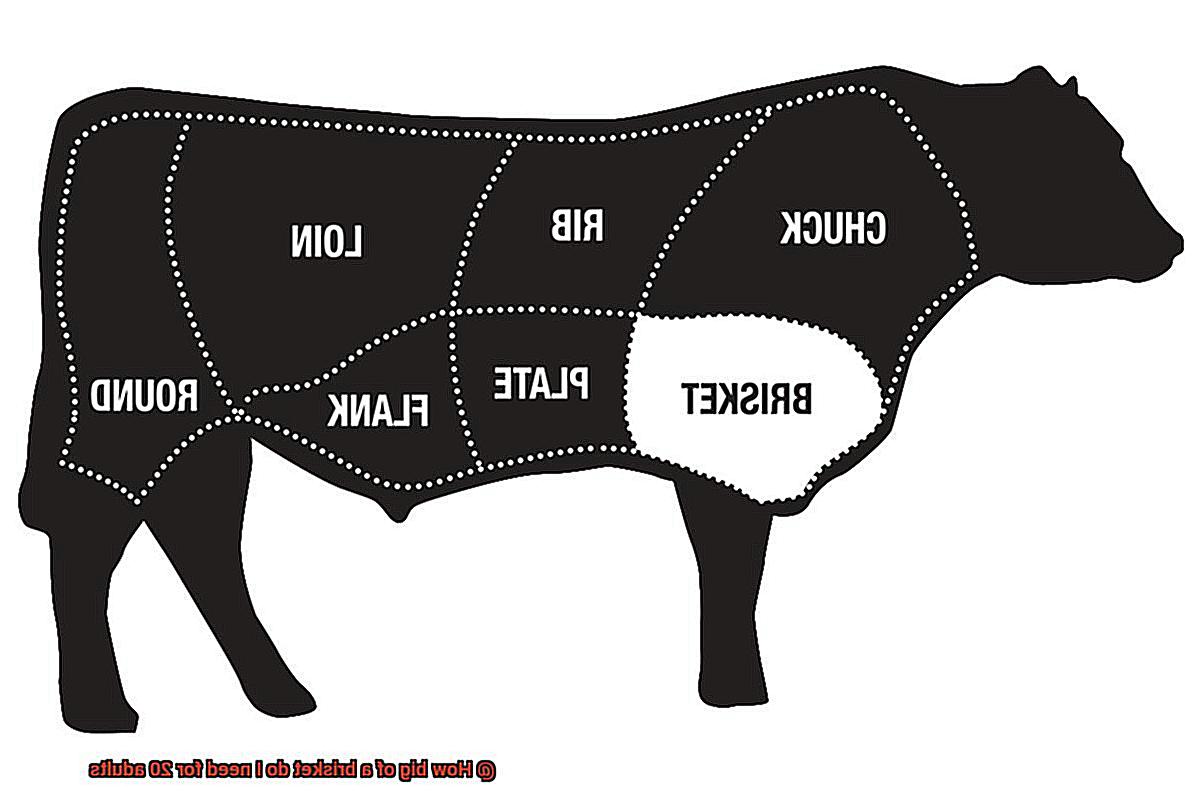
The Golden Ratio:
When it comes to estimating portion sizes, we embark on a quest to strike the perfect harmony between satisfying hearty appetites and avoiding an avalanche of leftovers. For our esteemed adult guests, follow the golden rule of planning approximately 1/2 pound of meat per person. Remember, though, that various factors can sway this estimate.
The Majestic Brisket:
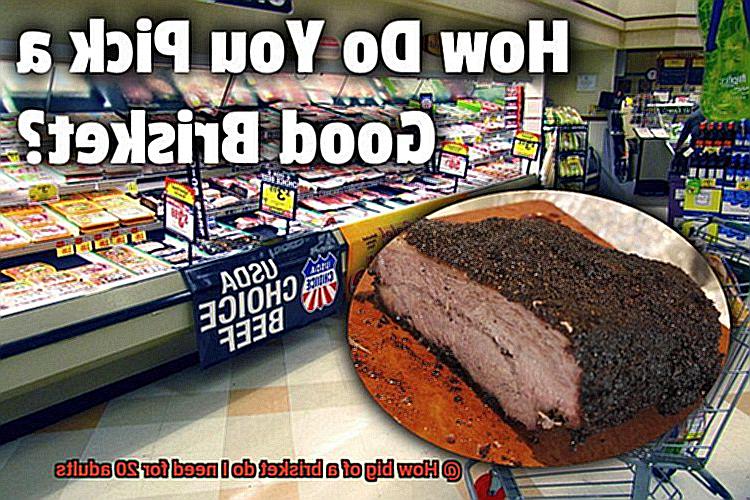
Ah, the crown jewel of any feast – the brisket. Known for its tender embrace and irresistible flavor, this majestic cut of meat warrants its own portion size considerations. Bear in mind that during its transformative journey through the cooking process, brisket tends to experience a significant reduction in weight – about 40% of its raw form. To satiate the palates of 20 adults, equip yourself with approximately 10 pounds of raw brisket (20 x 0.5 pounds). But hold on tight…
Ascend to Success by Rounding Up:
To ensure your culinary masterpiece caters to all and leaves no one yearning for more, embrace the wisdom of rounding up your estimations. In this case, consider procuring a generous 12-pound brisket – a shield against unforeseen shrinkage during cooking and a guarantee of succulent leftovers to savor.
Nurturing Diverse Dietary Desires:
As a considerate host, it is paramount to nurture the dietary needs and desires of your esteemed guests. Some may appreciate smaller portions or abstain from meat altogether. Extend your hospitality to vegetarian or vegan guests by offering delectable alternatives that celebrate their unique palates.
Planning Ahead for Extra Food
In our quest to create unforgettable gatherings, we have explored the intricate details of estimating the perfect brisket size. Now, let us embark on a journey that will unveil the secrets of planning ahead for extra food when hosting a gathering with 20 adults. Prepare to tantalize your taste buds and captivate your guests as we delve into expert tips that will elevate your hosting skills to new heights.
Unleashing Portion Perfection
- Delve into the world of gastronomy by considering the average portion size per person, a delectable 8 ounces (or 1/2 pound) of succulent brisket.
- Remember, appetites vary like flavors in a spice bazaar, so err on the side of abundance rather than scarcity.
- Multiply this tantalizing portion size by the number of hungry adults (20) to determine the grand total of brisket required.
Conquering Cooking Losses
- Like a seasoned warrior, bravely face the challenge of cooking losses that befall your beloved brisket.
- Through the heat of the culinary battlefield, remember that a raw brisket loses approximately 30% of its weight due to shrinkage and moisture loss during cooking.
- To emerge victorious with ample servings, augment the calculated weight by an additional 30%, triumphantly accounting for these cooking losses.
The Grand Calculation and Considerations
- With your culinary arsenal prepared, behold the final calculation that shall sate the hunger of 20 adults and leave room for savory remnants.
- The enchanting figure reveals itself as approximately 13 pounds (or 208 ounces) of uncooked brisket, promising an indulgent feast with potential leftovers.
- Bear in mind that a surplus of food is a banquet’s armor, as guests may crave seconds or possess appetites as vast as the ocean’s depths.
- Embark on a culinary odyssey by catering to the dietary restrictions and preferences of your esteemed guests, ensuring their enjoyment of alternative options alongside the magnificent brisket.
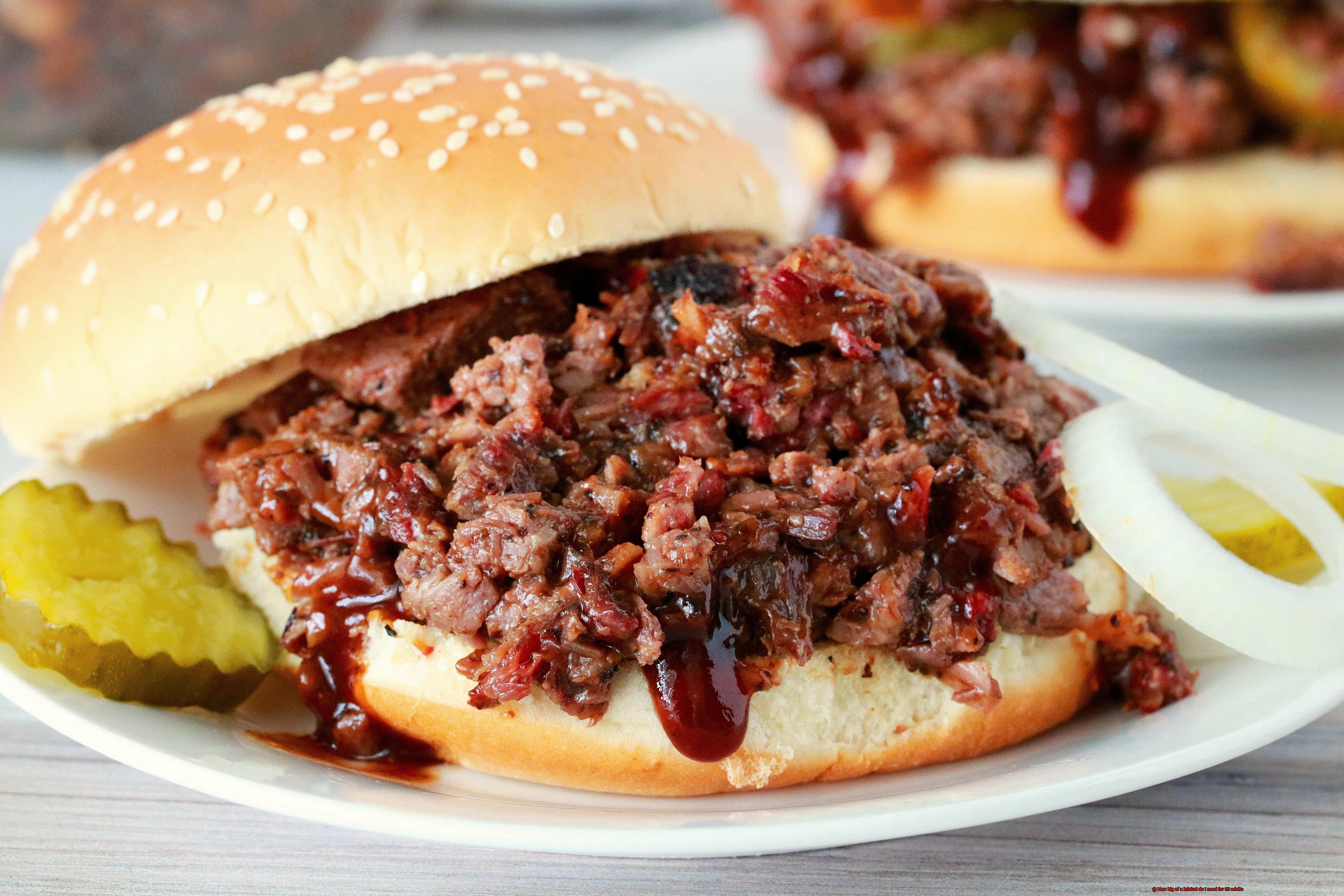
Purchasing a Larger Brisket than Needed
In our previous post, we delved into the intricacies of estimating the perfect brisket size for your gathering, leaving your guests mesmerized and yearning for more. But today, we’re ready to let you in on a little secret that will elevate your brisket game to new heights: purchasing a larger brisket than needed.
Strap in as we embark on a journey to uncover why going big is the ultimate strategy when hosting a grand feast.
The Shrinkage Factor:
Imagine this: you’ve painstakingly calculated the amount of brisket required, ready to dazzle your guests. However, as the cooking process unfolds, your magnificent brisket begins to shrink like a deflating balloon.
Suddenly, panic sets in as the realization dawns upon you – there might not be enough meat to satiate everyone’s appetite. Fear not, for purchasing a larger brisket comes to the rescue. By accounting for shrinkage during cooking, you can ensure that every attendee leaves your gathering with a contented stomach.
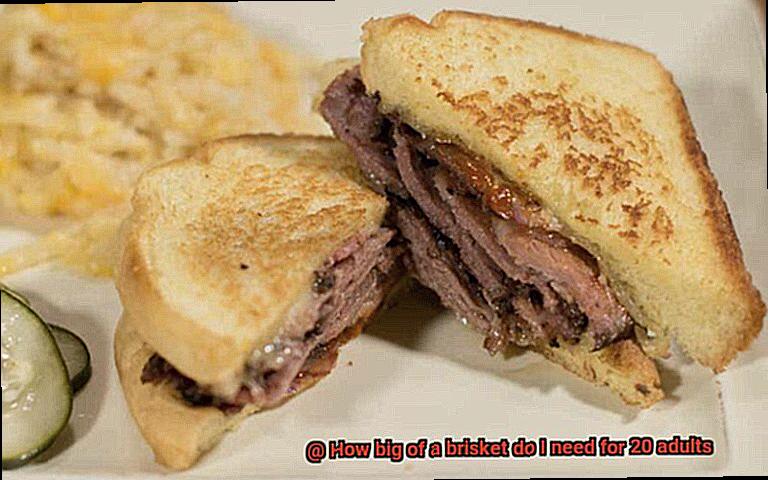
The Appetite Conundrum:
Let’s face it; some of us possess an insatiable hunger, capable of devouring more than our fair share of succulent meat. When hosting a large gathering, it is essential to consider these voracious appetites. While the general rule advises 1 pound of brisket per person, dare to push boundaries by increasing that estimate to 1.5 pounds if your guests are known for their passionate devotion to all things meat or if the brisket is the unrivaled star of the show without any alternative main course options.
Quality Matters:
The quality of your chosen brisket can significantly impact its cooking characteristics. Premium cuts tend to be leaner, boasting minimal fat and connective tissue, resulting in less shrinkage during the cooking process. If you’ve indulged in a top-of-the-line brisket, feel free to stick with the 1-pound per person estimate without hesitation. However, for those who opt for a more cost-effective cut, prudence suggests veering towards a larger brisket size to compensate for potential shrinkage.
Benefits of Having Extra Food on Hand
Imagine unexpected guests arriving at your doorstep, their appetites ready to be satisfied. Or picture a sudden power outage leaving you without access to your usual food supplies. In both scenarios, having extra food on hand can be a lifesaver. But did you know that there are even more benefits to keeping a well-stocked pantry and freezer? In this article, we will explore the various advantages of having extra food readily available, ranging from being prepared for unexpected guests to saving money and reducing food waste.
Preparedness for Unexpected Guests:
One of the greatest benefits of having extra food on hand is the ability to effortlessly accommodate unexpected guests. Whether it’s a last-minute dinner invitation or surprise visitors dropping by, you can be a gracious host without breaking a sweat. With extra food readily available, you won’t have to panic or run to the grocery store in a frenzy. Instead, you can focus on making your guests feel welcome and appreciated, ensuring that everyone leaves with a smile on their face.
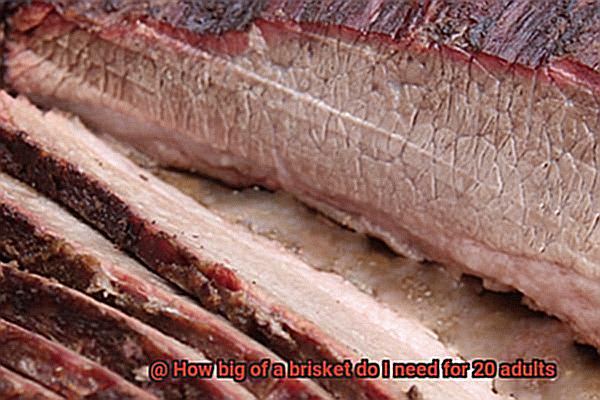
Readiness for Emergency Situations:
Life can throw unexpected curveballs, like natural disasters or power outages, that disrupt our access to food supplies. By having extra food stored in your pantry or freezer, you can face these emergencies with confidence. No matter how long the situation lasts or how limited your access to groceries becomes, you and your family will have enough sustenance to weather the storm. This sense of security is especially valuable for those living in areas prone to extreme weather conditions or with limited access to grocery stores.
Cost Savings:
Who doesn’t love saving money? One significant advantage of having extra food on hand is the potential for cost savings. Buying in bulk or taking advantage of sales allows you to score lower prices and discounts. By stocking up on non-perishable items or freezing excess food, you can avoid paying premium prices during high-demand periods or when certain ingredients are out of season. Plus, having extra ingredients readily available can curb the temptation to order takeout or dine out, ultimately saving you money on restaurant meals.
J9tmQ3X6bwU” >
Conclusion
In conclusion, when it comes to feeding a crowd of hungry adults, the size of your brisket matters.
For a group of 20 adults, you’ll want to aim for a substantial cut that can satisfy everyone’s appetites. Remember, briskets shrink during cooking, so it’s always better to err on the side of too much rather than too little.
This will ensure that no one goes home hungry and everyone leaves with satisfied taste buds.

